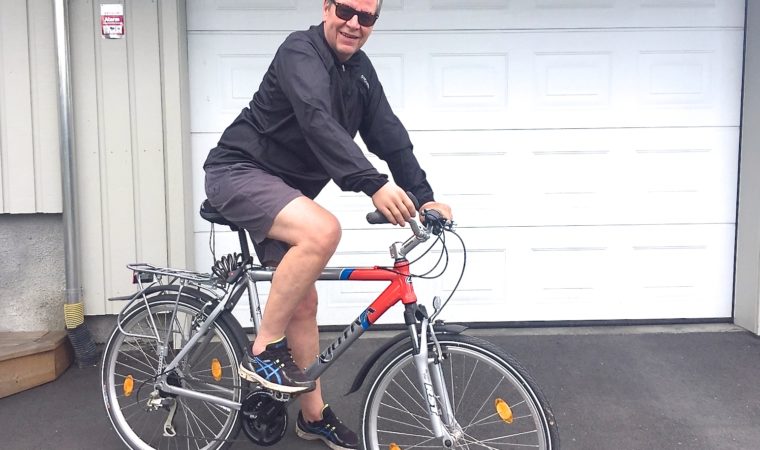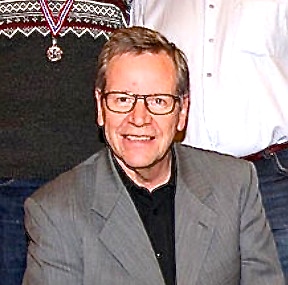– Erfaringsutveksling med andre amputerte har hjulpet meg svært mye

Geir-Håkon er veldig aktiv på fritiden. Sykkelen har han fått ombygd med spesialhåndtak som gjør det mulig å sykle som normalt. Foto: private. Etter amputasjonen av høyre arm måtte Geir-Håkon lære seg å skrive og ta lappen på nytt. Takket være flittig bruk av flere armproteser og hjelpemidler, lever han et aktivt og fullgodt liv. […]

Etter amputasjonen av høyre arm måtte Geir-Håkon lære seg å skrive og ta lappen på nytt. Takket være flittig bruk av flere armproteser og hjelpemidler, lever han et aktivt og fullgodt liv.
Av Marte Nordahl
I november 2015 var det kun en måned til 69- år gamle Geir-Håkon Øverby fra Elverum skulle gå over i en pensjonisttilværelse. Ute hadde det snødd og regnet på morgenen. Han var på vei til å legge ved på et bord til kapping, da han skled på glatta og falt rett inn i kappsagen.
– Jeg var veldig heldig. Det var ikke mange centimeterne om å gjøre før det kunne endt katastrofalt. Jeg kappet høyre overarm to ganger, sier Geir-Håkon.
Geir-Håkon lå hardt skadet i nesten en halvtime før sykebil kom og kjørte han rett til sykehuset Innlandet i Elverum. Han ble fraktet videre med helikopter til Rikshospitalet.
Amputerte samme dag
Før han ble lagt i narkose på Rikshospitalet visste han at armen ikke kunne reddes.
– Mange amputasjoner er planlagt av medisinske årsaker. Grunnet den alvorlige og traumatiske ulykken var amputasjonen helt uforutsett. Selve operasjonen skjedde med et fullt legeteam samme ettermiddag som jeg ankom Rikshospitalet. Jeg fikk beholde halve overarmen på cirka 25 centimeter, sier Geir-Håkon.
Savnet en samtale med kirurgen
Han løfter fram den gode veiledningen og hjelpen han fikk både på Rikshospitalet og på sykehuset i Innlandet i Elverum.
– Dernest savnet jeg en god samtale med kirurgen i etterkant av operasjonen. Rett etter operasjonen fikk jeg tilbud om psykolog som jeg ikke følte noe behov for. Jeg fikk også god hjelp av fysioterapeut, ergoterapeut og sykepleiere etter operasjonen.
Tidlig informert om Momentum
Geir-Håkon fikk kjennskap til Momentum for første gang på sykehuset i Innlandet i Elverum. Her var han under sårbehandling etter ulykken.
– En av sykepleierne lurte på om jeg var interessert i å se gjennom en konvolutt med informasjon om Momentum. Jeg reagerte veldig positivt på dette. I etterkant har jeg hørt at ikke alle har fått den tilsvarende informasjonen, sier han.
Geir-Håkon meldte seg inn i Momentum noen uker etter ulykken. Han er godt fornøyd med å ha vært medlem i Momentum de siste fire årene.
– I Momentum treffer jeg på likesinnede og mange hyggelige medlemmer, selv om armamputerte er i klart mindretall.
Besøk av en likeperson i Momentum
Tidlig i rehabiliteringsfasen havnet han på rehabiliteringsavdelingen på sykehuset i Innlandet- avdeling på Ottestad, like utenfor Hamar. Den første dagen fikk han besøk av en likeperson fra Momentum.
– Jeg hadde en veldig god samtale med vedkommende og reagerte positivt på oppmerksomheten fra dem.
Geir-Håkon gikk sykemeldt i et halvt år etter amputasjonen. Oppholdet på rehabiliteringsavdelingen gjorde han forberedt og klar til å komme tilbake til hverdagen.
Tilpasset en armprotese
Etter endt opphold på rehabiliteringsbehandlingen våren 2016, ble han sendt til Norsk Teknisk Ortopedisk verksted på Ottestad like utenfor Hamar. De spesialiserer seg på armproteser.
– Her fikk jeg enestående hjelp i alle ledd. I begynnelsen brukte vi mye tid på få tilpasset protesen på millimeteren. Det var veldig spennende å være med i prosessen. Etterhvert fikk jeg bedre signaler inn i sensorene. Etter to måneder fikk jeg fikk en optimal og veltilpasset protese med en hylse, sier han fornøyd.
Geir-Håkon er tilfreds over det fornøyelige resultatet. Rikshospitalet har også klart å få tak i en rest av biceps og triceps som er festet på protesen. Når han napper i den, gis det signaler inn i sensorene i protesen. Dermed klarer han å åpne og lukke hånden og gripe tak i ting.
Minimalt med smerter
– Rett etter amputasjonen føltes det som at jeg hadde både fingrene og armen intakt selv om den var borte. Følelsen forsvant gradvis etter to til tre uker og ble tilslutt helt borte.
– Jeg er takknemlig for at jeg er av de heldige som har opplevd minimalt med smerter etter amputasjonen. Jeg fikk kun noen få smertestillende tabletter rett etter operasjonen. I etterkant har jeg ikke fått behov for mer. Jeg har minimalt med fantomsmerter, sier han.
Normalt og aktivt liv
Geir-Håkon var også heldig med å få god behandling og oppfølging fra arbeidsgiveren i IF skadeforsikring.
– Jeg klarer å utføre de fleste aktiviteter i hjemmet, både ute og inne. Jeg gjør gledelig hagearbeid hvor jeg mestrer godt grove redskaper som trillebord, snømåking, gressklipper og spade. Siden jeg ikke lengre har noen finmotorikk i armen, får jeg ikke full kompensasjon gjennom en armprotese. Selv om finmotorikken i stor grad er borte, er jeg fornøyd med at jeg lever et normalt og aktivt liv. Som amputert er det viktigst å se på mulighetene fremfor begrensningene, sier han.
Aktiv på fritiden
I sommerhalvåret deltar han på tur- og bedriftsorientering iført protese. Med kart og kompass, i tillegg til en databrikke, får han ikke anvendt protesen like mye i bedriftsorienteringen. Dertil har han protesen med seg ut i skogen.
– I tillegg har jeg fått hjelp til å få bygget om en sykkel. Jeg tok mine første sykkelturer i fjor sommer, som bidro til å øke livsaktiviteten drastisk.
Geir-Håkon har tidligere spilt fotball og finner fortsatt stor glede i sporten. Han nøyer seg med å følge med på lokale kamper og på TV.

Lærte å skrive på nytt
Som høyrehendt måtte Geir-Håkon lære seg å skrive på nytt med protesen.
– Sammen med ergoterapeutene startet jeg først å trene på å tegne firkanter og streker. Når jeg mestret det gikk jeg over til å skrive bokstaver. Det var en stor overgang å lære seg å skrive på nytt.
– Jeg ble også nødt til å kjøpe meg ny elbil med automatgir. Dermed måtte jeg også ta lappen på nytt. Oppkjøringen gikk veldig bra. Det ble gjort om noen få ombygginger på bilen. I etterkant har jeg kjørt i 50 tusen kilometer. Bilturene gir meg veldig mye, sier han.
Tillitsvalgt og styremedlem i Momentum Innlandet
Geir-Håkon er også valgt som tillitsvalgt i Momentum- i tillegg til at han er fungerende nestleder i Momentum.
– Arbeidet gir meg mye. Selv ønsker jeg meg et større engasjement blant mange medlemmer. Likens er det fordelaktig å kunne involvere pårørende i større grad. Jeg synes det er synd at mange amputerte lever en passiv tilværelse. Med økt engasjement håper jeg på økt tilslutning og flere medlemmer. Dertil ønsker jeg at Momentum skal være en stor og sterk forening for hele landet, sier han.
Han framhever den lave medlemsmassen på 15 prosent blant armamputerte. Geir-Håkon understreker at han ønsker seg et større fokus på arm.
Likeperson
Geir-Håkon kurset seg til likeperson rett over nyttår. På rehabiliteringsavdelingen på Ottestad har han allerede hatt sine første likepersonssamtaler. Siden det generelt er få armamputerte er han ikke der like ofte.
– Samtalene var veldig givende og det føles naturlig for meg å komme dit, sier han fornøyd.
Viktig å se lyst på livet
– Det er viktig er å se lyst på livet når du har amputert. Mange kan sitte i det dypeste mørket og med de tyngste tankene. Ingen amputert må føle seg alene med slike utfordringer. Medlemskapet og involveringen i Momentum er svært meningsfullt. Det å ta kontakt med likepersoner er avgjørende for å opprettholde en god livskvalitet, sier Geir-Håkon.




